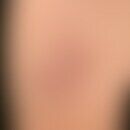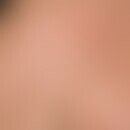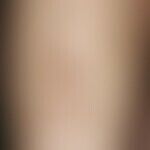Synonym(s)
HistoryThis section has been translated automatically.
The term "epidermal nevus" as hamartoma of the skin, points to v. Baerensprung, who first used the term"nevus unius lateris" (cited in Su et al.) for a systematized verrucous nevus in 1863.
DefinitionThis section has been translated automatically.
Congenital or appearing in the first years of life, to be interpreted as cutaneous mosaic, inflammatory or non-inflammatory, reddish-brown or dirty-brown, soft-papillomatous or wart-like-hard malformations of the epidermis (often with dermal component) or its appendages, which, apart from CHILD syndrome, manifest in the Blaschko lines or as other cutaneous mosaics.
Various epidermal hamartomas (epidermal nevi) should be considered as monitorial signs of complex syndromic malformations.
You might also be interested in
ClassificationThis section has been translated automatically.
The following distinctions can be made:
- Simple (non-organoid) epidermal hamartomas (nevi) (affecting only the epidermis)
- Compound "organoid" epidermal nevi (affecting epidermis and skin appendages)
- Epidermal nevi as monitorial signs for syndromes.
- Epidermal hamartomas (nevi):
- Papillomatous (soft) epidermal nevus (postzygotic mutations in FGFR3,PIK3CA, KRAS genes)
- Verrucous (hard) epidermal nevus (nevus verrucosus
)Special form: nevus
verrucosus unius lateralis - ILVEN
- Epidermolytic epidermal nevus (minus variant of keratosis plamoplantaris diffusa with mutations in keratin1)
- CHILD syndrome
- Corniculatus nevus
- Segmental M. Darier
- Segmental M. Hailey-Hailey ( Pemphigus chronicus benignus familiaris)
- Linear porokeratosis (linear manifestation of disseminated superficial actinic porokeratosis)
- Linear manifestation of plaque-like porokeratosis mibelli
- Organoid (compound) epidermal nevi:
- Nevussebaceus (proven mutations in the HRAS gene)
- Nevus comedonicus
- Porokeratotic eccrine ostium nevus (PEODDN)
- Hamartoma, eccrine
- Becker nevus
- Hair ne vus (see also curlyhair nevus)
- Munro's naevus.
- Epidermal nevi as monitoring signs for syndromes.
- Epidermal hamartomas (nevi):
Occurrence/EpidemiologyThis section has been translated automatically.
The incidence is estimated at 1:1000 children. In a larger study with 131 nevi occurring up to 14 years of age, 80% of the nevi were present at birth (Rogers M et al. 1989).
HistologyThis section has been translated automatically.
From a histopathological point of view (cited in Su 1982) the following classification results:
- acrokeratosis verruciformis-like
- Epidermolytic-hyperkeratotic
- Seborrheic keratosis-like
- Psoriasiform (eczematoid) - inflammatory linear verrucous epidermal nevus = ILVEN
- Wart-like (verrucous)
- Porokeratosis-like
- Acantholytic
- Comedon-like
LiteratureThis section has been translated automatically.
- The A et al (2014) Linear non-epidermolytic verrucous epidermal nevus. Indian Pediatr 51:591
- Fan YM et al (2014) An atypical variant of phacomatosis pigmentokeratotica: verrucous epidermal nevus, speckled lentiginous nevus, and pointed nevus associated with scoliosis. Int J Dermatol 53: 619-621
- Kruse LL et al (2015) Differential Diagnosis of Linear Eruptions in Children. Pediatr Ann.44:e194-e198
- Su WP(1082)Histopathological varieties of epidermal nevus. A study of 160 cases. At J Dermatopathol 4:161-170
- Rogers M et al (1989) Epidermal nevi and the epidermal nevus syndrome.
A review of 131 cases. J Am Acad Dermatol 20:476-88. - Waghmare RS et al. (2013) Inflammatory linear verrucous epidermal nevus. J Assoc Physicians India 61:431-432
Incoming links (13)
Angiokeratomas, acral pseudolymphomatous childhood; Cloves syndrome; Comedonic nevus; Cornicardial nevus; Curly hair nevus; Erbium yag laser; FGFR3 gene; Hypermelanosis nevoid, striped and vertebral; Linear proteus nevus; Naevus, papillomatous, soft epidermal; ... Show allOutgoing links (27)
Becker-naevus syndrome; Becker's nevus; Blaschko lines; Child syndrome; Comedonic nevus; Cornicardial nevus; Curly hair nevus; Dyskeratosis follicularis; FGFR3 gene; Haarnaevus; ... Show allDisclaimer
Please ask your physician for a reliable diagnosis. This website is only meant as a reference.

















